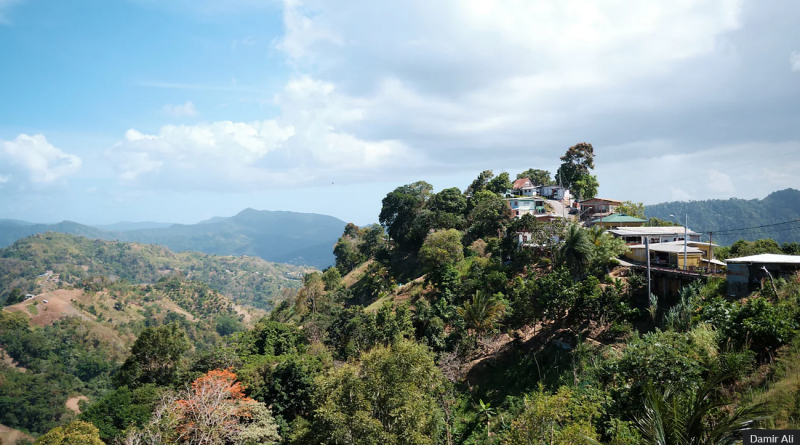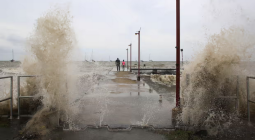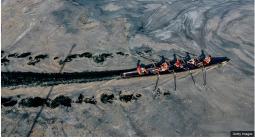Ahead of hurricane weather, vetiver is stabilising this Caribbean island's crumbling hillsides

The Caribbean is bracing itself for an intense hurricane season. A fragrant plant could help limit damage from extreme weather in Trinidad.
In the early hours on a Saturday morning, deep into the dry season, Mary Romany-Constantine makes her way down the steep hills of Paramin – a village on the northern coast of the Caribbean island of Trinidad – to a farmer's market in Diego Martin, with her wares in tow. Homemade wines, bars of soap, bundles of fragrant roots, all displayed on delicately woven mats and in decorative baskets – also for sale.
Romany-Constantine makes this wide variety of items all from a single plant that is now responsible for protecting much of the hilly land across Paramin. Its unique root system can function like a retaining wall for areas prone to land slippage when it is planted correctly. Around the world it is known as vetiver grass, but in Paramin the older residents who grew up using the plant call it "metiver".
The hillsides of the agricultural community are covered in beds of aromatic "green seasoning": chives, thyme, basil, parsley, mint, rosemary. But the roots of these plants are no match for the heavy rains of the June to December wet season, and every year communities like Paramin lose precious fertile topsoil to erosion and landslides. While locals give anecdotal information on the damage done over the years, there's a dearth of research on exactly how severe the problem is.
"Whenever we had a lot of rain, the farmers would have landslides and would lose some of their crops," says Romany-Constantine. She says she has long been connected to the greenery around her. In her garden, she grows perfumed vetiver, which is able to withstand the extreme weather that the islands are facing – primarily heavy rainfall which leads to flooding and landslides.
Climate change is dramatically increasing the risk of powerful hurricanes in the Caribbean and the region is currently bracing itself for a super-charged season. Early forecasts are estimating that 2024's Atlantic hurricane season could be among the most active on record.
The islands of Trinidad and Tobago lie on the edge of the "hurricane belt" and hurricanes rarely make landfall, but the islands are vulnerable to increased flooding and hillside erosion. Flash flooding and above-normal rainfall is predicted for this year.
For the past decade, the Paramin community has been working with IAMovement, a local non-profit organisation, to enable young people to plant vetiver along vulnerable hillsides to help protect the land from the flooding and landslides that come with more extreme weather in the rainy season.
Non-native, but not invasive
Vetiver grass itself is not native to the Caribbean, although there is anecdotal evidence of it growing here for at least the past 50 years. The plant is endemic to India, but the more commonly used types of vetiver have been introduced into many tropical countries, where it can thrive without becoming invasive – it requires human intervention to spread.
When removed from the ground, the fragrant roots can be used to produce an oil for perfumes and cosmetics or woven into mats and other crafts. But in the ground is where the plants really shine.
The word vetiver comes from the Tamil word vettiveru, meaning "root that is dug up" – and it is the vetiver roots that make it such a vital tool for soil protection and rehabilitation. A study on vetiver use in Australia and South Africa found the plant to be highly effective for land stabilisation and for revegetation of contaminated sites due to its tolerance for "extreme soil conditions including heavy metal contaminations".
The fibrous roots are thick when mature, and can extend down to 3m (10ft) deep within two years of planting – eventually reaching over twice that depth in suitable conditions. A hedge of vetiver creates a network of roots holding the land in place. The roots are incredibly strong. A study published in 1996 measured the tensile strength – the maximum stress a material can bear before breaking – of vetiver roots, with the average root strength being about one third of the tensile strength of steel. The roots also have the added impact of strengthening the soil that surrounds the roots.
Rehabilitating the landscape
For Jonathan Barcant, founder of IAMovement, the high rate of land slippage in Paramin – and the community's historical use of vetiver grass – made this community the ideal space to launch the vetiver education and planting programme. "I was desperately looking for green solutions," he says.
Barcant, who hails from the nearby town of Maraval and previously worked as an engineer on mining projects, found himself overwhelmed after witnessing the destructive impact the industry had on the environment around it.
Barcant's work involves rehabilitating the land that has been damaged by quarries, where vetiver can be planted to help make the soil more fertile for less hardy plants that are native to the region, unlike vetiver. Barcant's project has already seen success. The initiative is currently engaging community members from the Turure area of Sangre Grande, where quarrying has left land in need of remediation. The participants learn how to work with vetiver grass, sargassum seaweed for mulching, and reforestation with native trees to rehabilitate the landscape. The IAMovement's "Me We Green" programme has helped establish over 158,0000 vetiver plants in nine communities across the country.
Romany-Constantine is one of several residents involved in Barcant's vetiver project. She hopes to use the plant to stabilise the land around her house.
"It makes such a difference," says Romany-Constantine. "It's been helping a lot of people… It actually works like a wall – where I'm building my house, instead of building a wall I’m going to plant [vetiver]."
The grass also helps water from rainfall to infiltrate the soil more widely rather than just flowing over the top of the land and taking the top layer of soil with it. A 2019 study in Ethiopia found that the tight mesh of a vetiver root system slows water flow and helps it to seep deeper into the soil.
For Aidan Farrell, senior lecturer in plant physiology at the University of the West Indies, St Augustine Campus, vetiver is one of several plant "tools" that can help alleviate the issues of flooding and erosion on a smaller scale.
"The scientific community is on the lookout for these nature-based solutions more than ever when it comes to climate change," says Farrell. "As a solution, [vetiver] is more of a limited scale – it's not a whole habitat; it's one species."
Trinidad and Tobago is slipping into the hurricane …There could be massive destruction in the country – John Agard
The importance of protecting slopes matters not only to the people who live there, but also the communities in the nearby valleys. "Areas such as Port of Spain are surrounded by slopes where the native vegetation has been removed," says Farrell. He notes that flash flooding and landslips have been associated with extreme weather like tropical storms making landfall in Trinidad. "Restoring vegetation would help retain moisture in the soil and hold the soil together, reducing the risk of flooding and landslides."
But solving the problem requires ongoing care, says Farrell. "Planting is easy, but keeping healthy vegetation throughout the tropical dry season is difficult."
Holding up the community
Another of Barcant's projects works with communities in Laventille, a town just outside the capital city of Port of Spain. Unlike the rural Paramin, Laventille is a densely populated area.
Jennifer Cumberbatch, a long-time Laventille resident, watched as the house where she was raised collapse and slid down the hillside. "From childhood growing up, that area used to slip," she says, adding that underground springs nearby made the soil unstable.
In 2022, the entire side of the hill fell away. After the landslip, Cumberbatch says, her daughter did some research and found out about IAMovement's local "Me We Green" programme.
While on a site visit to Cumberbatch's house, Barcant is shown the remains of a road nearby, which is now a thin strip of asphalt with two gouged-out cliffs on either side. While the land around Cumberbatch is falling away, the slopes around her plot is holding firm with curving rows of dense vetiver.
The first batch of over 700 vetiver plants took about an hour or two to plant, with the Cumberbatch family working the soil alongside four members of the IAMovement team. Within four months, they had a flourishing row of hedges.
Not all vetiver planting projects are a resounding success. Further north, Mary Romany-Constantine's sister Julie, known to family and friends as Erlyn, has also been a part of the vetiver planting programme. The mountain wall overlooking her house is layered with thin vetiver. But unlike the hearty bushes at other locations, these have not grown as full. Because of their position on the mountainside, they are shaded from the sun for most of the day.
This is one of the limitations of working with vetiver – Barcant notes that he has observed the grass needs a great deal of direct sunlight to thrive. For it to be an effective solution, it needs to be planted in a structured manner to achieve the underground root wall effect provided by the hedgerows. In addition, vetiver growth can be slow. In situations where a piece of land is in urgent need of support, Barcant says, it may be better to use other options like a retaining wall, as the plants need at least two years to grow to an effective depth.
Shifting hurricane paths
Like many of the mountainous parts of Trinidad and Tobago, Paramin has always been susceptible to the landslides and soil erosion that accompany the region's rainy season, although data on exactly how affected the area has been is sparse.
Romany-Constantine recalls how farmers across the hillsides have lost many crops over the years to landslips. As climate change alters the Caribbean's rainy season, solving this issue becomes more urgent. The Caribbean Regional Climate Centre has noted that this year could see an intense wet season.
Trinidad and Tobago's position just outside of the main passageway for hurricanes has offered some protection. Though hurricanes have only made landfall in Trinidad and Tobago twice in recorded history, the devastation was intense. Hurricane Flora hit in 1963, and subsequently destroyed 2,750 of Tobago's 7,500 houses, caused massive landslides, felled 75% of Tobago's trees, and killed 20 people across the two islands.
But the climate crisis may be altering that trajectory, according to John Agard, professor of tropical island ecology at The University of the West Indies. Hurricanes thrive on warmer waters, and climate change affects sea-surface temperatures across the globe.
"Trinidad and Tobago is slipping into the hurricane zone because of heat development," says Agard. "There could be massive destruction in the country."
Habitat-wide restoration
Ultimately, to see a widespread rehabilitation of Trinidad's landscapes, Farrell stresses it is important to look to large-scale reforestation of native vegetation. Farrell points to the success of the country's other main island, Tobago, and the effect of protecting the Main Ridge Forest Reserve, a mountainous forest across the spine of the island and the oldest legally protected forest reserve in the world.
Walking through one of the trails across the reserve, you can feel the difference in moisture – the soil is damp even during the scorching dry season affecting the rest of the island this year. According to Farrell, this protection means older, more resilient root systems across the ridge, which help protect the land from landslides in the rainy season and forest fires in the dry. He says that in the mountains of Trinidad's northern range, where large swathes of tree cover have been removed, replanting is vital to rehabilitating the landscape – and vetiver is just one of many tools in a wider arsenal.
As the islands prepare for the possibility of intensified wet seasons and perhaps a future of hurricanes reaching the shores of Trinidad and Tobago, it is important that community projects like this one work in tandem with a range of other nature-focused responses to the issues surrounding climate change, says Farrell.
"People are looking for nature-based solutions," he says. "That includes bringing agroforestry intro agriculture, maintaining mangroves on the coast to avoid coastal erosion, and trying to maintain native forests."
With such incredible biodiversity at their fingertips, he says, that the island has many natural tools to reach for, and vetiver is just one of them.





